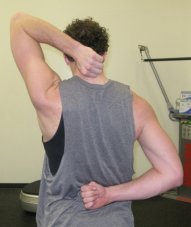Thoracic Spine Mobility:
When we talk about the performance capabilities of the shoulder, we are mostly talking about overhead athletes. This includes things like throwing a football, throwing a baseball, swimming, an overhead dumbbell press, or anything else that requires an athlete to take their had above their head.
Obviously, in just about all sports, overhead movements are required and important, but in some sports, such as baseball, volleyball, softball, and swimming, shoulder performance is not the only thing affecting their sport performance, but it is very close. Because of this, understanding Thoracic Spine Mobility and it’s affect on shoulder stability are extremely important for the coach, trainer, and athlete.
As we discussed in the section about shoulder joint pain, we know that when you follow the chain from the Thoracic Spine to the Scapula and then to the glenohumeral joint, the Thoracic Spine is the foundation for the stable shoulder.
To learn more about this connection click here…
So, we know that shoulder instability is unfavorable for shoulder health, and instability is also not advantageous for athletic performance in most cases. But, we also know that even if the shoulder is stable, poor Thoracic Spine mobility will decrease performance in the overhead athlete.
 The first, and most obvious way that it affects performance, is through a decreased range of motion. Many athletes without adequate Thoracic Spine extension will not be able to reach full shoulder flexion. If that athlete is a throwing athlete, they will likely lose velocity when throwing. This is because they are unable to put the shoulder through the range of motion which is most advantageous for throwing. Because they are unable to reach this full range, their performance will most certainly suffer.
The first, and most obvious way that it affects performance, is through a decreased range of motion. Many athletes without adequate Thoracic Spine extension will not be able to reach full shoulder flexion. If that athlete is a throwing athlete, they will likely lose velocity when throwing. This is because they are unable to put the shoulder through the range of motion which is most advantageous for throwing. Because they are unable to reach this full range, their performance will most certainly suffer.
In another example, swimmers rely on the combination of shoulder range of motion and trunk rotation for power (as do volleyball, softball, and baseball athletes). If they are lacking in Thoracic Spine rotation, they will be unable to rotate their shoulders during the act of pulling through the water. Without the ability to rotate, they are unable to fully realize the potential of their obliques, lats and other musles of the core. Without the huge power generation of these muscles, performance suffers.
The upper body is connected to the lower body through the core. Because of this, the core is foundation for all athletic movement. The core is directly connected to the spine in multiple positions. Without mobility in the spine, the core doesn’t activate properly and robs the body of valuable energy. This loss then ripples to every extremity, because if the foundation of athletic movement isn’t stable, the extremities have to constantly fight to make up for that lack of stability. Sooner or later, something will break down somewhere in the chain. It all depends where the weak link is in the chain. At the end of the day, it comes down to specific mobility and stability to stay healthy and perform well.
Learn more about how the Thoracic Spine affects other movements:
Learn about mobility of the T-Spine:
Looking for more help? Schedule a consultation today!
Back to Thoracic Spine MobilityBack to Injury Rehabilitation
Back to Home


Leave a Reply